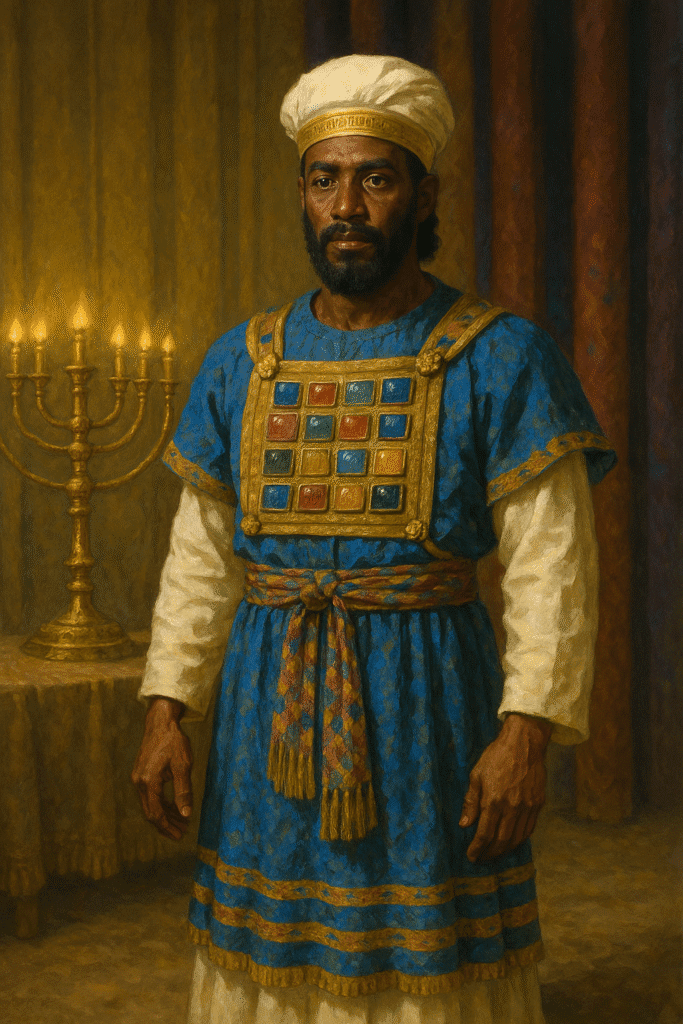Introduction – Exodus 28 Summary
This Exodus 28 Summary shifts from the design of the tabernacle to the people who will serve within it. This Exodus 28 summary explains God’s instructions for the garments of Aaron and his sons—garments created for glory, beauty, holiness, and consecration. Through these garments, God teaches Israel how a mediator must be prepared before entering His presence.
Visit our hub article for Everything Ark, Tabernacle, and Priesthood.
The Calling of Aaron and His Sons (Exodus 28:1–5)
God chooses Aaron and his sons—Nadab, Abihu, Eleazar, and Ithamar—to minister as priests. Their appointment is God’s decision, not human choice. Skilled artisans are commanded to make holy garments for them, garments designed “for glory and for beauty.”
These garments do not simply clothe the priests—they set them apart. Every thread reminds Israel that no one approaches God casually. Holiness requires preparation, consecration, and obedience.
The Ephod (Exodus 28:6–14)
The ephod is woven from gold, blue, purple, scarlet, and fine linen. It includes two onyx stones set in gold. Each stone is engraved with the names of six tribes of Israel.
As Aaron enters God’s presence, he literally carries the nation on his shoulders—an image of both representation and responsibility. Golden chains secure the ephod and connect it to the breastplate, symbolizing unity between the priest, the people, and God.
The Breastplate of Judgment (Exodus 28:15–30)
The breastplate is a square pouch adorned with twelve precious stones, each engraved with the name of a tribe. These stones reflect the equal value of the tribes before God.
Inside the breastplate are the Urim and Thummim, instruments used to discern God’s will in matters of judgment. The breastplate rests over Aaron’s heart, showing that the priest’s intercession is compassionate, deliberate, and personal.
Every decision he makes before God is made with the people upon his heart.
The Robe of the Ephod (Exodus 28:31–35)
The robe is woven entirely of blue, pointing to the heavenly nature of the priest’s work. The opening for the head is reinforced so it cannot tear—contrasting with the temple veil that will one day tear at Christ’s death.
Around the hem are alternating bells of gold and pomegranates made from blue, purple, and scarlet yarn. The bells announce the priest’s movement inside the Holy Place, signaling that he is accepted and alive as he ministers. The pomegranates symbolize fruitfulness—life produced from faithful service.
The Golden Plate: “Holiness to the LORD” (Exodus 28:36–38)
A golden plate engraved with HOLINESS TO THE LORD is fastened to the turban and rests on Aaron’s forehead. It declares the purpose of the priesthood: to stand before God in holiness.
Aaron bears the guilt associated with the holy things that Israel offers. His role foreshadows the greater High Priest who will bear the iniquity of His people perfectly.
The Linen Garments (Exodus 28:39–43)
The chapter concludes with instructions for tunics, sashes, caps, and linen breeches for Aaron’s sons. These garments ensure modesty and purity as the priests perform their duties. Failure to wear them properly brings death, demonstrating God’s holiness.
Linen symbolizes righteousness—clean, light, and pure. The priests must serve without corruption, teaching Israel that those who approach God must do so in holiness.
Conclusion – Exodus 28 Summary
I hope this Exodus 28 Summary presented a detailed portrait of the priesthood. Every piece of clothing—the ephod, breastplate, robe, golden plate, and linen garments—teaches Israel about representation, holiness, responsibility, and intercession.
All these elements point forward to Christ, our perfect High Priest, who bears our names, carries our burdens, intercedes continually, and brings us into God’s presence not through garments or rituals, but through His own life and sacrifice.
